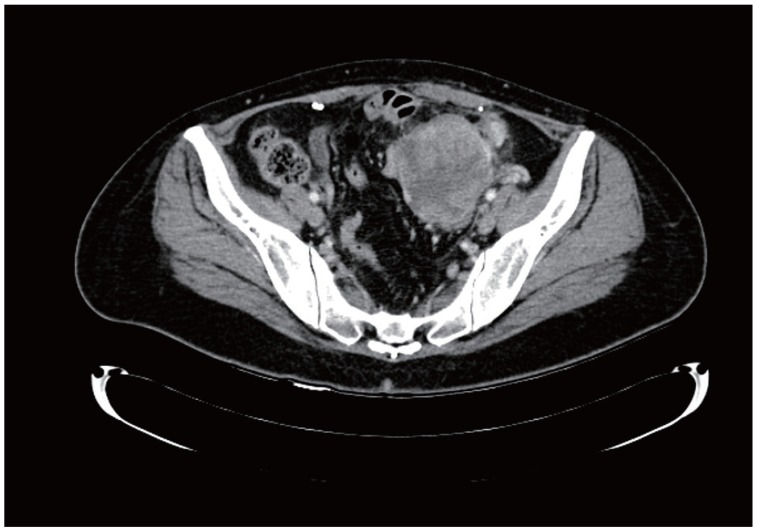Obstet Gynecol Sci.
2020 Mar;63(2):205-208. 10.5468/ogs.2020.63.2.205.
Germline PALB2, ATM variants in a patient with breast and ovarian cancer at risk for familial cancer syndrome: Is there a role for risk-reducing salpingo-oophorectomy?
- Affiliations
-
- 1Divisions of Internal Medicine, Department of Medicine, College of Medicine, University of Florida, Gainesville, FL, USA.
- 2Divisions of Hematology and Oncology, Department of Medicine, College of Medicine, University of Florida, Gainesville, FL, USA.
- 3Divisions of Maternal-Fetal Medicine, Department of Obstetrics and Gynecology, College of Medicine, University of Florida, Gainesville, FL, USA.
- 4Divisions of Gynecologic Oncology, Department of Obstetrics and Gynecology, College of Medicine, University of Florida, Gainesville, FL, USA. joelcardenas@ufl.edu
- KMID: 2471759
- DOI: http://doi.org/10.5468/ogs.2020.63.2.205
Abstract
- A 50-year-old non-Hispanic white Caucasian female was diagnosed with breast cancer and was subsequently found to possess the tumorigenic ataxia telangiectasia mutated (ATM) and PALB2 variants but not the BRCA1 and BRCA2 variants. She visited the gynecologic oncology office for routine counseling about risk-reducing salpingo-oophorectomy (RRSO). Although the patient was asymptomatic, an adnexal mass was discovered in the physical examination performed by palpation. Upon using pre-operative imaging techniques, an 8 cm complex adnexal mass was identified. Her CA-125 level was elevated. She underwent complete cytoreductive surgery. Pathological analysis showed a stage IC clear cell carcinoma of the left ovary; subsequently, she received 6 cycles of adjuvant chemotherapy with a combination of carboplatin and paclitaxel. The patient exhibited no signs ovarian cancer in a follow-up appointment after 32 months of treatment. However, bilateral RRSO is not recommended for patients positive for ATM and PALB2. Breast cancer patients with PALB2 and ATM mutations should extensively discuss the risks and benefits of RRSO in light of current data.
MeSH Terms
Figure
Reference
-
1. Siegel RL, Miller KD, Jemal A. Cancer statistics, 2019. CA Cancer J Clin. 2019; 69:7–34. PMID: 30620402.
Article2. NCCN. Genetic/familial high-risk assessment: breast and ovarian cancer. Version 2.2019. Fort Washington (PA): National Comprehensive Cancer Network;2018. 7. 30.3. Kim HS, Kim TH, Chung HH, Song YS. Risk and prognosis of ovarian cancer in women with endometriosis: a meta-analysis. Br J Cancer. 2014; 110:1878–1890. PMID: 24518590.
Article4. Gay GM, Lim JS, Chay WY, Chow KY, Tan MH, Lim WY. Reproductive factors, adiposity, breastfeeding and their associations with ovarian cancer in an Asian cohort. Cancer Causes Control. 2015; 26:1561–1573. PMID: 26342607.
Article5. Kurian AW, Ward KC, Howlader N, Deapen D, Hamilton AS, Mariotto A, et al. Genetic testing and results in a population-based cohort of breast cancer patients and ovarian cancer patients. J Clin Oncol. 2019; 37:1305–1315. PMID: 30964716.
Article6. Ramus SJ, Song H, Dicks E, Tyrer JP, Rosenthal AN, Intermaggio MP, et al. Germline mutations in the BRIP1, BARD1, PALB2, and NBN genes in women with ovarian cancer. J Natl Cancer Inst. 2015; 107:djv214. PMID: 26315354.7. Norquist BM, Harrell MI, Brady MF, Walsh T, Lee MK, Gulsuner S, et al. Inherited mutations in women with ovarian carcinoma. JAMA Oncol. 2016; 2:482–490. PMID: 26720728.
Article8. Antoniou AC, Casadei S, Heikkinen T, Barrowdale D, Pylkäs K, Roberts J, et al. Breast-cancer risk in families with mutations in PALB2. N Engl J Med. 2014; 371:497–506. PMID: 25099575.
Article9. Lu HM, Li S, Black MH, Lee S, Hoiness R, Wu S, et al. Association of breast and ovarian cancers with predisposition genes identified by large-scale sequencing. JAMA Oncol. 2019; 5:51–57. PMID: 30128536.
Article10. Carter NJ, Marshall ML, Susswein LR, Zorn KK, Hiraki S, Arvai KJ, et al. Germline pathogenic variants identified in women with ovarian tumors. Gynecol Oncol. 2018; 151:481–488. PMID: 30322717.
Article11. Lilyquist J, LaDuca H, Polley E, Davis BT, Shimelis H, Hu C, et al. Frequency of mutations in a large series of clinically ascertained ovarian cancer cases tested on multi-gene panels compared to reference controls. Gynecol Oncol. 2017; 147:375–380. PMID: 28888541.
Article12. Walsh T, Casadei S, Lee MK, Pennil CC, Nord AS, Thornton AM, et al. Mutations in 12 genes for inherited ovarian, fallopian tube, and peritoneal carcinoma identified by massively parallel sequencing. Proc Natl Acad Sci U S A. 2011; 108:18032–18037. PMID: 22006311.
Article13. Harter P, Hauke J, Heitz F, Reuss A, Kommoss S, Marmé F, et al. Prevalence of deleterious germline variants in risk genes including BRCA1/2 in consecutive ovarian cancer patients (AGO-TR-1). PLoS One. 2017; 12:e0186043. PMID: 29053726.14. Kotsopoulos J, Sopik V, Rosen B, Fan I, McLaughlin JR, Risch H, et al. Frequency of germline PALB2 mutations among women with epithelial ovarian cancer. Fam Cancer. 2017; 16:29–34. PMID: 27631815.15. Kurian AW, Hughes E, Handorf EA, Gutin A, Allen B, Hartman AR, et al. Breast and ovarian cancer penetrance estimates derived from germline multiple-gene sequencing results in women. JCO Precis Oncol. 2017; 1:1–12.
Article
- Full Text Links
- Actions
-
Cited
- CITED
-
- Close
- Share
- Similar articles
-
- Prevalence of PALB2 Germline Mutations in Early-onset and Familial Breast/Ovarian Cancer Patients from Pakistan
- Uptake Rate of Risk-Reducing Salpingo-Oophorectomy and Surgical Outcomes of Female Germline BRCA1/2 Mutation Carriers: A Retrospective Cohort Study
- Frequency of BRCA1 and BRCA2 Germline Mutations Detected by Protein Truncation Test and Cumulative Risks of Breast and Ovarian Cancer among Mutation Carriers in Japanese Breast Cancer Families
- Factors associated with the decision to undergo risk-reducing salpingo-oophorectomy among women at high risk for hereditary breast and ovarian cancer: a systematic review
- Prevalence and Risk Factors of Germline Pathogenic Variants in Pancreatic Ductal Adenocarcinoma


